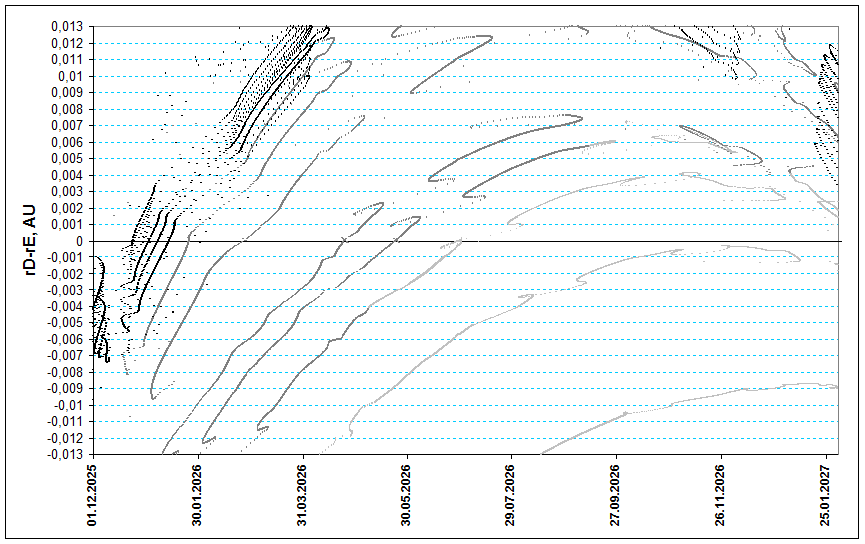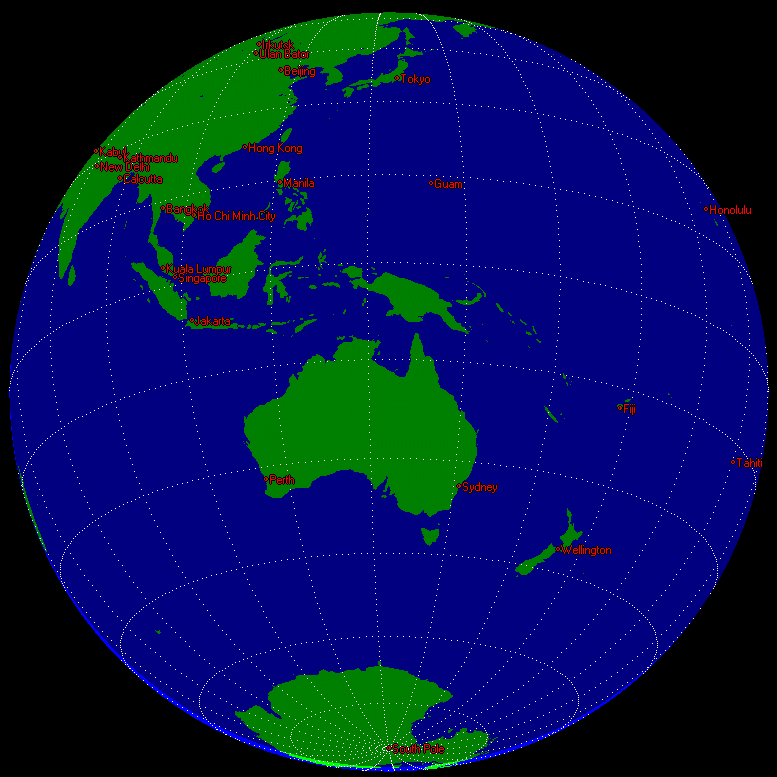249P-ids 2023: prediction of activity
to the list of predictions

Fig. 1. Space-temporal projection of 45P-ids trails parts onto their minimal distance passages in 2022 (correspondence between colours of the particles and their ejection velocities can be seen here).

Fig. 2. Detailed space-temporal projection of 45P-ids trails parts onto their minimal distance passages in 2026.
In 2026 on April 18 the Earth is expected to encounter the 1969 trail ejected by the comet 249P/LINEAR. This is a small comet which is expected to pass its next perihelion in 2025 at 0.5 AU from the Sun. The orbit of this comet comes close to the orbit of the Earth in two points, at solar longitudes corresponing April 18 with MOID 0.074 AU and November 3 with MOID 0.045 AU. The cometary orbit is closer at the second (November) point and this also creates possibility for meteor activity in 2025 and 2026, it will be described briefly below, but the radiant of November outbursts is very close to the Sun position in the sky.
Parameters of the April 18 encounter are the following. Time of maximum is 14:42 UT, rD-rE is -0.00083 AU, particles ejection velocity is 36.64 m/s, trail density is 308.7% of that for a 1 rev. Leonids trail.
In a whole these parameters are quite favorable as they mean that the Earth comes relatively close to rather dense and regular trail. Ejection velocity is quite high meaning small particles size and low meteor brightness. Prediction of intensity is difficult as no past activity occurances of the shower has been observed before, but ZHR could be very roughly estimated at several dozens meteors. Entry velocity is 28 km/s so meteors of the shower are quite slow.
The computations also show that the stream of the comet 249P/LINEAR could produce meteor activity in the autumn of 2025 and 2026. In 2025 due to large number of encountered trails activity is expected to persist during quite long period approximately from 14 UT on November 2 to 17 UT on November 3. Expected ZHR is at several dozens meteors, computed radiant is RA=217°, Dec=-5.9° and its elongation from the Sun is only 9°, which makes almost impossible any observations except of using radar and radio methods.
In 2026 the autumn activity is expected due to encounters to 1992 and 1997 trails. Both trails have maxima on November 2, one from 1992 trail is at 16:58 UT and from 1997 trail is at 19:09 UT. The radiant is the same as in 2025 - RA=217°, Dec=-5.9° which also makes any activity from these trails almost unobservable except of radar and radio methods.

Fig. 3. The Earth as seen from coming 249P-ids meteors (RA=205.7°, Dec=-19.9°) during the expected maximum time of outburst from 1969 trail on April 18 апреля at 14:42 UT.
Returning to the outburst on 2026 April 18, in case it occurs at the expected time it will be visible very well at major part of hight hemisphere as, in contrast to the November crossing, the radiant of the shower in April has elongation from the Sun of 179°, i.e. it is situated almost opposite to the Sun in the sky. Considering the computed time of maximum it should be visible very well in Australia and New Zealand as well as in neighbouring territories of South-Eastern Asia and Oceania. The Moon will have just passed new phase so it won't create any problems for observations.
References
1. "Comet's dust 2.0" program by S. Shanov and S. Dubrovsky. [Used for orbital computations.]
2. E. Lyytinen, T. van Flandern "Predicting the strength of Leonid outbursts", 2000, Earth, Moon, and Planets, P. 149-166.
3. Jenniskens P. Meteor showers and their parent comets, 2006, 780 p.
4. Kasuo Kinoshita, http://jcometobs.web.fc2.com/ [Orbital elements of the comet 249P/LINEAR]
5. Hewgill G. Xearth 1.1.0 (Software program), 2003.
References
1. "Comet's dust 2.0" program by S. Shanov and S. Dubrovsky. [Used for orbital computations.]
2. E. Lyytinen, T. van Flandern "Predicting the strength of Leonid outbursts", 2000, Earth, Moon, and Planets, P. 149-166.
3. Jenniskens P. Meteor showers and their parent comets, 2006, 780 p.
4. Kasuo Kinoshita, http://jcometobs.web.fc2.com/ [Orbital elements of the comet 249P/LINEAR]
5. Hewgill G. Xearth 1.1.0 (Software program), 2003.